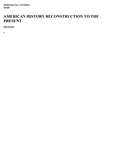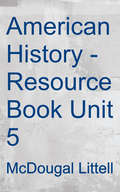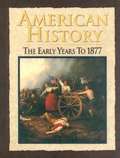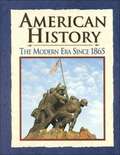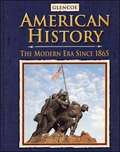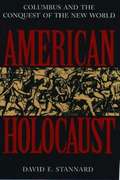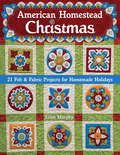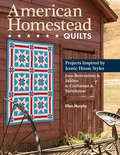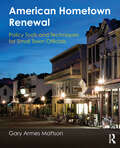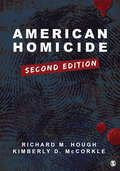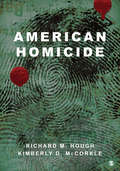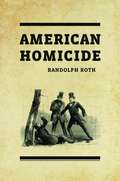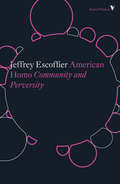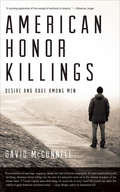- Table View
- List View
American History: Reconstruction to the Present
by Robert Dallek Donna M. Ogle Jesus Garcia C. Frederick RisingerNIMAC-sourced textbook
American History: Reconstruction to the Present
by Houghton Mifflin Harcourt StaffHISTORY programming greatly appeals to educators and young people who are drawn into the visual stories our documentaries tell. Our Education Department has a long-standing record in providing teachers and students with curriculum resources that bring the past to life in the classroom. Our content covers a diverse variety of subjects, including American and world history, government, economics, the natural and applied sciences, arts, literature and the humanities, health and guidance, and even pop culture.
American History: Student Edition 2018
by Holt McdougalBy delivering an immersive experience through compelling narratives enriched with media, we're connecting you to history through experiences that are energizing, inspiring, and memorable. The following pages highlight some digital tools and instructional support that will help you approach history through active inquiry, so you can connect to the past while becoming active and informed citizens for the future.
American History: The Early Years to 1877
by Donald A. Ritchie Albert S. BroussardThe history of America, from its beginning to the post Civil War era.
American History: The Early Years to 1877
by Donald A. Ritchie Albert S. Broussard McGraw-Hill Companies StaffThe book American History: The Early Years To 1877 has a great amount of information in it, it is an example of nonfiction writing as it describes real-life events, people, ideas, and places.
American History: The Modern Era Since 1865
by Donald A. RitchieImagine a United States without computers, telephones, or automobiles, where women and most minoritites cannot vote, a place where 8 to 10 people work on farms, and higher education is privilege reserved for the fortunate few.
American History: The Modern Era since 1865
by Donald A. RitchieThe book contains unit lessons on Creating A Nation Prehistory to 1815, Forging a Nation 1815-1877, New Horizons 1860-1900, Entering a New Century 1867-1920, Crusade and Disillusion 1911-1932, Times of Crisis 1932-1960, Redefining America 1954-Present plus additional features of Atlas, United States Databank, Presidents of the United States, Career Connections Handbook, etc.
American History: The Modern Era since 1865
by Donald A. RitchieImagine a United States without computers, telephones, or automobiles, where women and most minorities cannot vote, a place where 8 of 10 people work on farms, and higher education is a privilege reserved for the fortunate few.
American History: We the People
by Mara L. Pratt Reed R. SimonsenThis is the story of the birth of the nation, the signing of the U.S. Constitution, the War of 1812 and the struggles that followed. Volume Two is a photo-reproduction of an original history book used in 1890 to teach our children the grandeur of the America vision. These pages contain the stories of countless men, women and children who bravely built a new land into the great bastion of freedom we enjoy today. This book contains the history that schools leave out. It is unfortunate that many of the stories of patriotism are set aside today for current events and more recent historical interpretations. In the mad rush to offer a little piece of history from each American era, the truly inspirational events of our Founding Fathers are lost.
American Holidays
by Abigail BetancesIn this book, author has mentioned the yearly calendar, month and day the Flag Day comes for America.
American Holocaust: The Conquest of the New World
by David E. StannardHow we destroyed more than one-hundred million of the earlier inhabitants of the New World.
American Home Products Corp.
by David W. Mullins Jr.American Home Products is a company with virtually no debt. Students are asked to analyze the company's debt policy and make a recommendation to the CEO. It is likely that adding debt to the capital structure would create some value for shareholders; the CEO is firmly against borrowing.
American Homelessness: A Reference Handbook (3rd edition)
by Mary Ellen HombsHombs (of the Massachusetts Housing and Shelter Alliance) offers a collection of reference materials that provide information on the pervasive problem of homelessness in the United States. Nine chapters offer a chronology of the homeless problem, brief biographical sketches of 20 people who have had an effect on homeless policy and research, statistical information, documents and government reports, legislation from the U.S. and Europe written to address the problem, a list of print and nonprint resources, and a directory of organizations and government agencies. Also included is a brief analysis and discussion of the problem, comparing Europe and the United States.
American Homestead Christmas: 21 Felt & Fabric Projects for Homemade Holidays
by Ellen MurphySimple to stitch, perfect for gifts: Make your Christmas crafty with handmade ornaments, stockings, tree skirts, and more!American Homestead is back again—this time with charming small projects you can sew anytime, anywhere. Ellen Murphy shares twenty-one embroidered felt and quilted designs for the holidays in her signature folk-art style. These classic patterns can also be stitched up in alternate colors to be suitable all year round. Festive projects, from all-new felt ornaments to cheerful stockings, make beautiful tree trimmings and treasured gifts for family and friends.
American Homestead Quilts: Projects Inspired by Iconic House Styles from Brownstone & Saltbox to Craftsman & Farmhouse
by Ellen MurphyPair timeless quilt designs and classic American homes with this book featuring “lyrical commentary [and] clear how-tos” (Publishers Weekly).Designer Ellen Murphy has created unique quilts inspired by the colors and shapes of American houses. From colonial farmhouses to brownstones, these quilts will beautify any décor. This book includes patterns and complete instructions for nine traditional pieced quilts in a variety of sizes and color palettes, plus inspirational photos featuring iconic American homes. Classic-styled quilts are perfect for building your sewing skills: Begin with simple squares and work your way up to more challenging diamond patterns.
American Hometown Renewal: Policy Tools and Techniques for Small Town Officials
by Gary A. MattsonBefore the interstates, Main Street America was the small town’s commercial spine and served as the linchpin for community social solidarity. Yet, during the past three decades, a series of economic downturns has left many of the great small cities barely viable. American Hometown Renewal is the first book to combine administrative, budgetary, and economic analysis to examine the economic and fiscal plight currently facing America’s small towns. Featuring a blend of theory, applications, and case studies, it provides a comprehensive, single-source textbook covering the key issues facing small town officials in today’s uncertain economy. Written by a former public manager, university professor, and consultant to numerous small towns in the Heartland, this book demonstrates the ways in which contemporary small towns throughout the nation are facing economic challenges brought about by the financial shocks that began in 2008. Each chapter explores a theme related to small town revival and provides a related tool or technique to enable small town officials to meet the challenges of the 21st Century.?Encouraging local small town officials to look at the economic orbit of communities in a similar manner as a town’s budget or a family’s personal wealth, examining its specific competitive advantages in terms of relative assets to those of competing communities, this book provides the reader with step-by-step instructions on how to conduct an asset inventory and apply key asset tools to devise a strategy for overcoming the challenges and constraints imposed upon spatially-fixed communities. American Hometown Renewal is an essential primer for students studying city management, economic community development, and city planning, and will be a trusted handbook for city managers, geographers, city planners, urban or rural sociologists, political scientists, and regional microeconomists.
American Homicide
by Richard M. Hough Kimberly D. McCorkleAmerican Homicide examines all types of homicide, and gives additional attention to the more prevalent types of murder and suspicious deaths in the United States. Authors Richard M. Hough and Kimberly D. McCorkle employ more than 30 years of academic and practitioner experience to help explain why and how people kill and how society reacts. This brief, yet comprehensive book takes a balanced approach, combining scholarly research and theory with compelling details about recent cases and coverage of current trends. Comparative coverage of homicide types and rates in countries around the world shows how American homicide statistics compare internationally.
American Homicide
by Richard M. Hough Kimberly D. McCorkleAmerican Homicide examines all types of homicide, and gives additional attention to the more prevalent types of murder and suspicious deaths in the United States. Authors Richard M. Hough and Kimberly D. McCorkle employ more than 30 years of academic and practitioner experience to help explain why and how people kill and how society reacts. This brief, yet comprehensive book takes a balanced approach, combining scholarly research and theory with compelling details about recent cases and coverage of current trends. Comparative coverage of homicide types and rates in countries around the world shows how American homicide statistics compare internationally.
American Homicide
by Richard M. Hough Professor Kimberly D. McCorkleAmerican Homicide examines all types of homicide, and gives additional attention to the more prevalent types of murder and suspicious deaths in the United States. Authors Richard M. Hough and Kimberly D. McCorkle employ more than 30 years of academic and practitioner experience to help explain why and how people kill and how society reacts. This compressive text takes a balanced approach combining scholarly research and theory with compelling details about recent cases and coverage of current trends.
American Homicide
by Richard M. Hough Professor Kimberly D. McCorkleAmerican Homicide examines all types of homicide, and gives additional attention to the more prevalent types of murder and suspicious deaths in the United States. Authors Richard M. Hough and Kimberly D. McCorkle employ more than 30 years of academic and practitioner experience to help explain why and how people kill and how society reacts. This compressive text takes a balanced approach combining scholarly research and theory with compelling details about recent cases and coverage of current trends.
American Homicide
by Randolph RothIn American Homicide, Randolph Roth charts changes in the character and incidence of homicide in the U.S. from colonial times to the present. Roth argues that the United States is distinctive in its level of violence among unrelated adults—friends, acquaintances, and strangers. America was extraordinarily homicidal in the mid-seventeenth century, but it became relatively non-homicidal by the mid-eighteenth century, even in the slave South; and by the early nineteenth century, rates in the North and the mountain South were extremely low. But the homicide rate rose substantially among unrelated adults in the slave South after the American Revolution; and it skyrocketed across the United States from the late 1840s through the mid-1870s, while rates in most other Western nations held steady or fell. That surge—and all subsequent increases in the homicide rate—correlated closely with four distinct phenomena: political instability; a loss of government legitimacy; a loss of fellow-feeling among members of society caused by racial, religious, or political antagonism; and a loss of faith in the social hierarchy. Those four factors, Roth argues, best explain why homicide rates have gone up and down in the United States and in other Western nations over the past four centuries, and why the United States is today the most homicidal affluent nation.
American Homo: Community and Perversity
by Jeffrey EscoffierA sweeping account of the way lesbian, gay, and bisexual people have challenged and changed societyIn this provocative book, Jeffrey Escoffier tracks LGBT movements across the contested terrain of American political life, where they have endured the historical tension between the homoeroticism coursing through American culture and the virulent periodic outbreaks of homophobic populism. Escoffier explores how every new success enables a new disciplinary and normalizing form of domination; only the active exercise of democratic rights and participation in radical coalitions allows LGBT people to sustain the benefits of community and the freedom of sexual perversity.
American Honor Killings: Desire and Rage Among Men
by David McconnellIN AMERICAN HONOR KILLINGS, straight and gay guys cross paths, and the result is murder. But what really happened? What role did hatred play? What about bullying and abuse? What were the men involved really like, and what was going on between them when the murder occurred? This book explores the truth behind squeamish reporting and uninformed political rants of the far right or fringe left. David McConnell, a New York-based novelist, researched cases from small-town Alabama to San Quentin's death row. The book recounts some of the most notorious crimes of our era.<P> BEGINNING IN 1999 and lasting until last year's conviction of a youth in Queens, New York, the book shows how some murderers think they're cleaning up society. Surprisingly, other killings feel almost preordained, not a matter of the victim's personality or actions so much as a twisted display of a young man's will to compete or dominate. We want to think these stories involve simple sexual conflict, either the killer's internal struggle over his own identity or a fatally miscalculated proposition. They're almost never that simple.<P> TOGETHER, THE CASES FORM A SECRET AMERICAN HISTORY of rage and desire. McConnell cuts through cant and political special pleading to turn these cases into enduring literature. In each story, victims, murderers, friends, and relatives come breathtakingly alive. The result is more soulful, more sensitive, more artful than the sort of "true crime" writing the book was modeled on. A wealth of new detail has been woven into old cases, while new cases are plumbed for the first time. The resulting stories play out exactly as they happened, an inexorable sequence of events--grisly, touching, disturbing, sometimes even with moments of levity.

